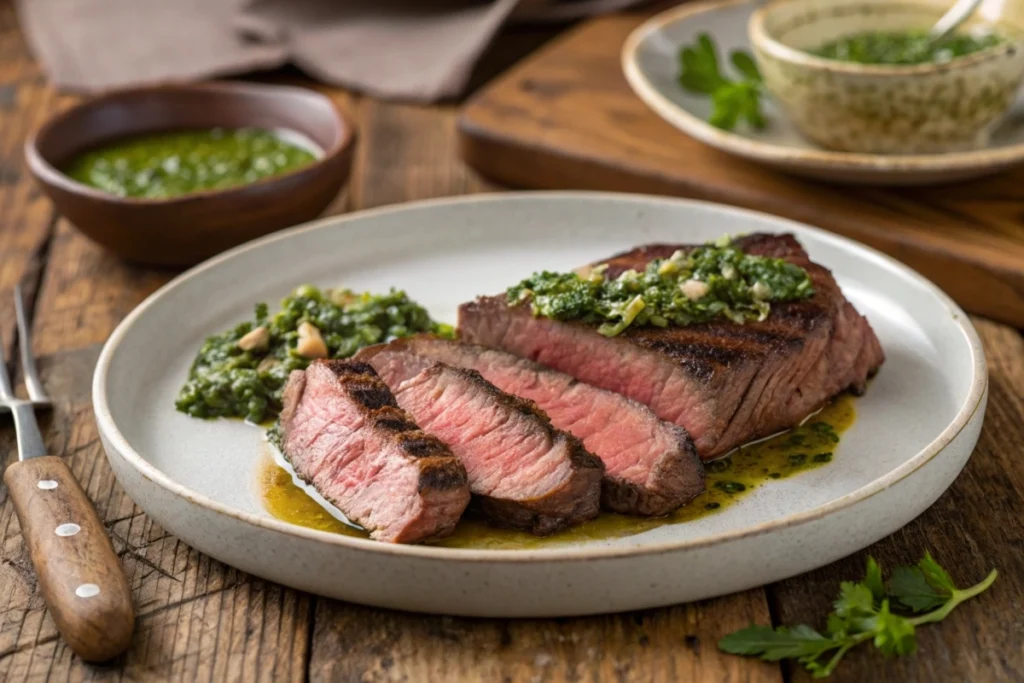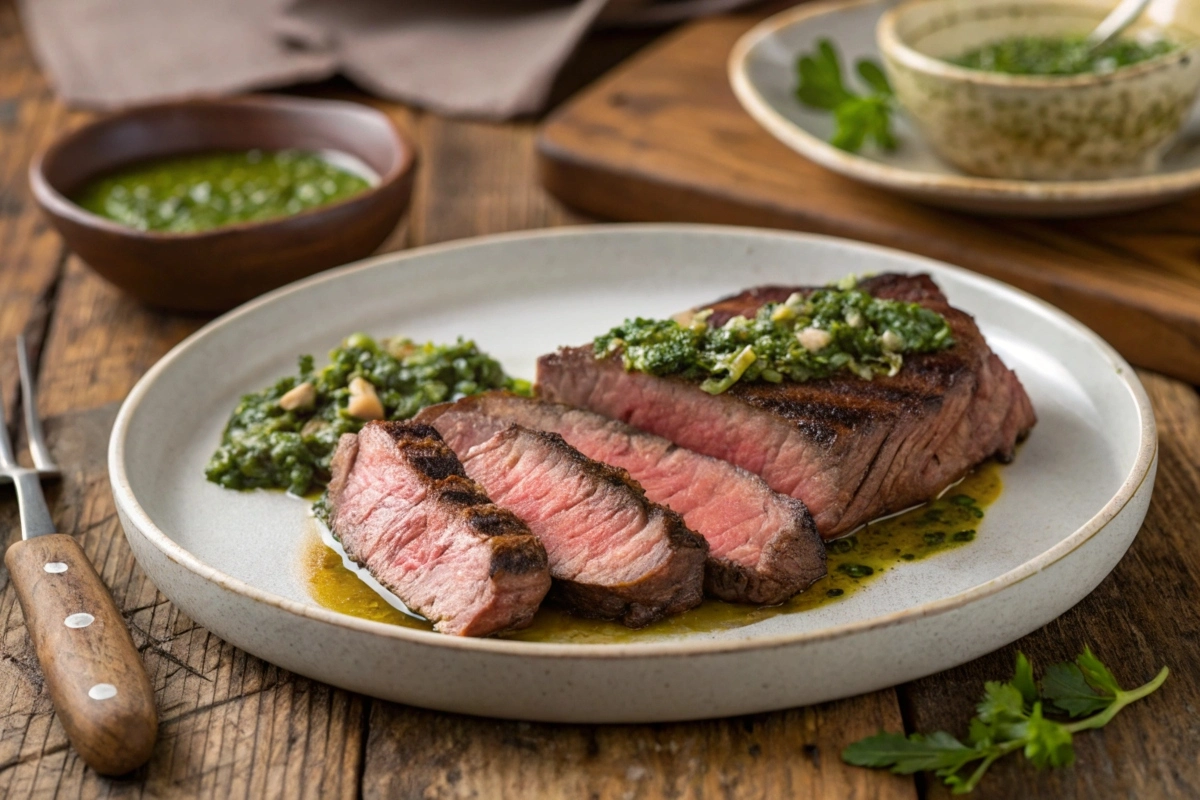Beef bavette, also known as flap steak or sirloin flap, is a gem of a cut that has stolen the spotlight in kitchens worldwide. Whether you’re a home cook exploring new culinary horizons or a seasoned chef perfecting a classic, beef bavette is a versatile, flavorful cut worth knowing. This article covers everything from its origins and selection to preparation, cooking methods, and serving suggestions. Get ready to transform your steak game with this comprehensive guide!

Introduction to Beef Bavette
What is Beef Bavette?
If you’ve ever wondered what gives certain steaks their rich, juicy flavor and tender texture, the beef bavette is a prime example. Cut from the bottom sirloin region, this steak boasts a loose, fibrous structure that soaks up marinades and seasonings like a sponge.
Interestingly, the term “bavette” comes from the French word for “bib,” reflecting its flat, bib-like shape. This cut is highly prized for its versatility—it’s perfect for grilling, pan-searing, or even sous vide cooking. While it’s gaining recognition globally, it has long been a staple in French cuisine, where it is often paired with sauces or used in rustic dishes.
Origins and History of Bavette Steak
Beef bavette has humble origins. In traditional French butchery, this cut was overlooked for being less tender than premium cuts like filet mignon or ribeye. However, chefs began to recognize its potential because of its marbling and deep beefy flavor.
The history of bavette also speaks to the importance of butchery techniques. French culinary traditions emphasize making the most of every cut, and bavette is a shining example of this ethos. Today, it’s celebrated for its affordability, accessibility, and ability to turn into a show-stopping meal with minimal effort.
Keep reading to dive deeper into the art of selecting, preparing, and mastering this extraordinary cut of beef!
Understanding the Cut
Where Does Bavette Come From on the Cow?
The beef bavette is cut from the bottom sirloin, nestled close to the flank and skirt steak regions. This part of the cow sees a moderate amount of movement, resulting in its characteristic loose texture and robust beefy flavor. Unlike more tender parts of the cow, the bottom sirloin offers cuts like bavette that are both versatile and economical, perfect for adventurous cooks.
Bavette’s proximity to other popular cuts—like flank and skirt steak—makes it easy to confuse them. However, it has its own unique identity. Thanks to its rich marbling, it delivers a juicy, flavorful experience, particularly when cooked with techniques that highlight its natural qualities.
In the world of butchery, knowing where a cut comes from is key to understanding its culinary potential. Bavette’s structure, loaded with connective tissue and a coarse grain, makes it ideal for slicing against the grain to maximize tenderness. Whether you grill, pan-sear, or braise it, this cut shines when handled thoughtfully.
Bavette vs. Flank and Skirt Steak: Differences and Similarities
It’s no surprise that people often compare bavette to flank and skirt steak—they all share a similar long, flat shape. Yet, they’re far from identical. Bavette, for instance, stands out for its marbling. This natural fat content lends it a juicier bite compared to the leaner flank steak.
Flank steak, on the other hand, is cut from the cow’s abdominal muscles and features a more muscular, less tender texture. While it’s excellent for slicing thin and serving in dishes like fajitas, it lacks the rich mouthfeel that bavette offers.
Skirt steak, cut from the plate section, is another close cousin. With its pronounced grain, it’s great for quick, high-heat cooking. However, it’s thinner and less forgiving than bavette, which holds up well in a range of preparations.
In short, bavette combines the best of both worlds: it has the robust beef flavor of skirt steak and the adaptability of flank steak, all wrapped up in a juicier, more forgiving package.
Selecting and Preparing Bavette
How to Choose Quality Bavette Steak
When it comes to selecting beef bavette, quality is everything. A good cut will have even marbling, the intramuscular fat that delivers that buttery, melt-in-your-mouth texture. The meat itself should display a deep red color—a hallmark of freshness.
Additionally, the steak should feel firm to the touch. Avoid cuts with a slimy texture or any off-putting odors, as these are clear signs the meat is past its prime. When in doubt, rely on trusted local butchers or reputable grocery stores, where knowledgeable staff can guide you to the best selection.
An excellent cut of bavette should be uniform in thickness, which helps it cook evenly. Thinner parts can overcook quickly, so watch for well-cut steaks. If available, ask your butcher to trim any excess fat or silver skin for you.
Preparing Bavette for Cooking: Trimming and Marinating
Before cooking your bavette steak, some prep work is essential. Begin by trimming away any visible silver skin—a tough membrane that can cause the steak to cook unevenly. A sharp knife will make this task quick and easy.
Next, consider marinating the steak. Bavette’s loose texture makes it ideal for absorbing marinades, which can enhance both its flavor and tenderness. A classic marinade might include soy sauce, olive oil, garlic, and fresh herbs like rosemary or thyme. For an added depth of flavor, try incorporating a splash of citrus juice or vinegar.
Allow the steak to marinate for at least 30 minutes, but for best results, aim for 4-6 hours in the refrigerator. Before cooking, pat the steak dry to achieve a better sear.
Cooking Techniques
Grilling Bavette Steak: Tips and Tricks
Grilling is one of the best ways to cook a bavette steak, as it highlights its natural beefy flavor and creates a smoky, charred crust. Start by preheating your grill to high heat. You want the grates to be scorching to ensure a good sear.
Season the steak generously with salt and pepper, or use your preferred steak seasoning. Place it on the grill, and let it sear for 2-3 minutes per side for medium-rare. Remember to flip only once to retain the juices and ensure even cooking. For a thicker bavette, move it to a cooler part of the grill after searing to finish cooking through.
Once cooked, let the steak rest for 5-10 minutes to allow the juices to redistribute. Always slice against the grain to maximize tenderness.
Pan-Searing Bavette: Achieving the Perfect Crust
Pan-searing is another fantastic way to cook a bavette steak, especially if you’re aiming for that golden-brown crust. Use a cast-iron skillet, as it retains heat exceptionally well.
Heat the skillet over high heat and add a small amount of oil with a high smoke point, such as canola or avocado oil. Once the oil shimmers, place the steak in the pan, being careful not to overcrowd it.
Sear the steak for about 2-3 minutes per side, flipping only once. For additional flavor, finish with a pat of butter and fresh herbs like thyme or rosemary. Baste the steak with the melted butter during the last minute of cooking to lock in flavor. Let it rest before slicing thinly against the grain.
Under a vacuum Method for Bavette Steak
The sous vide method is perfect for ensuring your bavette steak is cooked evenly and retains all its juices. Start by setting your sous vide machine to 130°F for medium-rare.
Season the steak generously with salt, pepper, and your favorite herbs or spices. Place it in a vacuum-seal bag or a resealable freezer bag, ensuring all the air is removed. Cook the steak in the water bath for 2 hours to achieve tender perfection.
After cooking, pat the steak dry and finish it on a blazing hot skillet or grill for about 1-2 minutes per side to develop a beautiful crust. This method guarantees precision, making it nearly impossible to overcook your steak.
Serving Suggestions
Slicing Bavette: Importance of Cutting Against the Grain
One of the most vital steps in serving beef bavette is mastering the art of slicing it. This cut’s signature loose and fibrous structure demands that it be sliced against the grain. But what does that mean, exactly?
The “grain” refers to the direction in which the muscle fibers run through the steak. By slicing perpendicular to these fibers, you effectively shorten them, making each bite easier to chew. Cutting with the grain, on the other hand, leaves long, tough strands that diminish the tenderness of the meat.
Here’s how to do it: After resting the steak for at least 5 minutes to lock in the juices, identify the direction of the grain—it usually runs lengthwise along the bavette. Use a sharp knife to make clean, thin slices at a slight diagonal. The result? A tender, melt-in-your-mouth steak that’s impossible to resist.
Recommended Side Dishes and Sauces for Bavette
What’s a perfect steak without the right sides and sauces? Indeed, the beef bavette’s bold, rich flavor pairs wonderfully with fresh, vibrant accompaniments.
For instance, a classic choice is chimichurri sauce—a tangy blend of parsley, garlic, olive oil, and vinegar that effortlessly cuts through the steak’s richness. Furthermore, other great options include shallot sauce, which adds a savory depth, or a creamy horseradish sauce for a bit of spice.
Similarly, for side dishes, roasted vegetables like asparagus, Brussels sprouts, or carrots provide a natural sweetness that perfectly complements the steak. Alternatively, a simple green salad with a zesty vinaigrette offers a refreshing balance. On the other hand, if you want to keep it French, pair the bavette with pommes frites (French fries) for a classic bistro-style experience.
Finally, elevate your presentation with rustic plating on wooden boards or sleek, modern plates for a restaurant-quality feel.
Nutritional Information
Nutritional Profile of Bavette Steak
Beef bavette is not only delicious but also packed with essential nutrients that contribute to a balanced diet. As a cut derived from the bottom sirloin, it boasts a high protein content, making it an excellent choice for those aiming to build or maintain muscle. A typical 3-ounce serving of bavette provides around 22 grams of protein, which is about 44% of the recommended daily intake for most adults.
This cut is also rich in iron, an essential mineral that supports oxygen transportation in the blood, and B vitamins, particularly B12, which is vital for nerve function and energy production. Its marbled texture indicates a moderate fat content, contributing to its robust flavor. However, this also means the cut has higher calorie levels compared to leaner steaks, so portion control is key for calorie-conscious eaters.
To keep your meal well-rounded, pair bavette steak with nutrient-dense sides such as leafy greens or roasted vegetables.
Beef bavette is a nutrient-rich cut that offers several health benefits when consumed in moderation. Packed with essential proteins, vitamins, and minerals, it’s a great addition to a balanced diet. However, its marbling contributes to a higher fat content, so portion control is key. Below is the nutritional breakdown for a 100g serving of bavette steak:
Nutritional Content (Per 100g)
| Nutrient | Amount (Per 100g) | % Daily Value* |
|---|---|---|
| Calories | 250 kcal | 12.5% |
| Protein | 22g | 44% |
| Total Fat | 18g | 23% |
| Saturated Fat | 7g | 35% |
| Iron | 2.8mg | 15% |
| Vitamin B12 | 2.1µg | 87% |
| Cholesterol | 70mg | 23% |
| Sodium | 60mg | 2.5% |
This table provides a clear view of how beef bavette fits into your dietary goals, ensuring you can enjoy this delicious cut while staying mindful of your nutritional intake.
Frequently Asked Questions
Is bavette a good cut of steak?
Absolutely! Bavette is a hidden gem in the steak world. Its marbling and loose texture make it flavorful, tender, and versatile, perfect for grilling, pan-searing, or sous vide cooking.
What is the best way to cook bavette?
While bavette excels on the grill for a smoky, charred flavor, it’s equally delicious when pan-seared to develop a caramelized crust or cooked sous vide for precision. Always slice against the grain for the best results.
Is beef bavette tender?
Yes, when cooked and sliced correctly, bavette is incredibly tender. Its natural marbling enhances juiciness, but it’s essential to avoid overcooking and always slice against the grain.
Is a bavette steak chewy?
If not prepared properly, bavette can be slightly chewy due to its fibrous structure. However, with proper slicing and cooking methods, it transforms into a tender, flavorful steak.
Conclusion
Beef bavette is a truly remarkable cut of steak that effortlessly blends flavor, versatility, and affordability. Additionally, with its deep marbling, rich taste, and fibrous texture, it offers endless possibilities for creative cooking. Whether grilled, pan-seared, or cooked sous vide, this cut undeniably shines when handled with care, ultimately delivering an unforgettable culinary experience.
Moreover, from selecting the finest cut to mastering slicing techniques and pairing it with the perfect sides, bavette steak embodies the art of thoughtful cooking. Not only does its nutritional profile make it a satisfying and nourishing choice for a balanced meal, but it also provides a flavorful way to indulge without compromising health goals.
Now that you’re equipped with the knowledge to prepare and serve this fantastic cut, why not make bavette steak the star of your next meal? In fact, dive into its unique flavor and texture—it just might become your new go-to steak!

